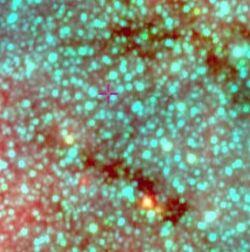Astronomy:VVV-WIT-07
| Observation data Equinox J2000.0]] (ICRS) | |
|---|---|
| Constellation | Scorpius |
| Right ascension | 17h 26m 29.387s[1] |
| Declination | −35° 40′ 56.20″[1] |
| Characteristics | |
| Astrometry | |
| Proper motion (μ) | RA: 2.469[1] mas/yr Dec.: 1.374[1] mas/yr |
| Parallax (π) | 2.5190 ± 1.1187[2] mas |
| Distance | approx. 1,300 ly (approx. 400 pc) |
| Details | |
| Other designations | |
Gaia DR2 5974962995291907584[1] | |
| Database references | |
| SIMBAD | data |
VVV-WIT-07 is a unique variable star which presents a sequence of recurrent dimmings (Ks~14.35 – 16.164)[1] with a possible deep eclipse in July 2012. The star, located in the Scorpius constellation about 23,000 ly (7,100 pc)[citation needed] away,[1] is not a binary star, which would eliminate such a system from explaining the various observed dimmings.[3]
Overview
The star was found by the "Vista Variables in the Via Lactea" (VVV) project, which is a survey of European Southern Observatory (ESO) variability of the innermost bulge of the Milky Way galaxy. The near-infrared spectra of VVV-WIT-07 appear without features, without prominent emission or absorption lines. The characteristics found in the light curve of VVV-WIT-07 (WIT refers to "What Is This?") are similar to those seen in J1407 (Mamajek's Object), a pre-MS K5 dwarf with a ring system that eclipses the star or, alternatively, to Tabby's star, an F3 IV/V star that shows irregular and aperiodic obscurations in its light curve.[1][4][5][6][7][8][3]
From 2010 to 2018, the star dimmed and brightened irregularly (v~14.35 – 16.164),[1] and seemed similar to Tabby's star, except the light from VVV-WIT-07 dimmed by up to 80 percent, while Tabby's star faded by only about 20 percent.[8] Another star, J1407, however, has been found to have dimmed by up to 95%, which may be more similar to the light curve presented by VVV-WIT-07.[8] Nonetheless, according to ESO astronomer Valentin Ivanov, "A key word that could be used to describe our finding [of VVV-WIT-07] is extreme. In every aspect ... We have identified a system that challenges the imagination even more than usual, because it is so unlike our own planetary system."[3]
See also
- Disrupted planet
- List of stars that have unusual dimming periods
References
- ↑ 1.0 1.1 1.2 1.3 1.4 1.5 1.6 1.7 1.8 Saito, Roberto K. (2019). "VVV-WIT-07: another Boyajian's star or a Mamajek's object?". Monthly Notices of the Royal Astronomical Society 482 (4): 5000–5006. doi:10.1093/mnras/sty3004. Bibcode: 2019MNRAS.482.5000S.
- ↑ Brown, A. G. A. (2021). "Gaia Early Data Release 3: Summary of the contents and survey properties". Astronomy & Astrophysics 649: A1. doi:10.1051/0004-6361/202039657. Bibcode: 2021A&A...649A...1G. Gaia EDR3 record for this source at VizieR.
- ↑ 3.0 3.1 3.2 Ivanov, Valentin D. (22 March 2019). "What Is This? - Astronomers discover mysterious star displaying never-seen-before behaviour". European Southern Observatory. https://www.eso.org/public/usa/blog/what-is-this/.
- ↑ Saito, R.K. (6 November 2018). "VVV-WIT-07: another Boyajian's star or a Mamajek's object?". Monthly Notices of the Royal Astronomical Society 482 (4): 5000–5006. doi:10.1093/mnras/sty3004. Bibcode: 2019MNRAS.482.5000S.
- ↑ Seidel, Jamie (23 November 2018). "VVV-WIT-07: This ancient, erratic star hides a dark secret". The Advertiser. https://www.adelaidenow.com.au/technology/science/vvvwit07-this-ancient-erratic-star-hides-a-dark-secret/news-story/0b2b17f9b4aa41f2cde2da228f881a02.
- ↑ Anderson, Paul Scott (29 November 2018). "Have astronomers found another Tabby's Star? - Remember when astronomers found Tabby's Star and said they'd never seen anything like it? Now there's another one … maybe.". Earth & Sky. https://earthsky.org/space/is-vvv-wit-07-another-tabbys-star.
- ↑ Redd, Nola Taylor (21 November 2018). "Have Astronomers Found Another "Alien Megastructure" Star? - Scientists now have a second example of a strange stellar phenomenon speculatively linked to extraterrestrial intelligence in 2015". Scientific American. https://www.scientificamerican.com/article/have-astronomers-found-another-alien-megastructure-star/.
- ↑ 8.0 8.1 8.2 Grossman, Lisa (22 December 2018). "Astronomers spot another star that flickers like Tabby's star - It's unclear what's causing the newly discovered object to blink, but it's probably not aliens". Science News 194 (12): p. 9. https://www.sciencenews.org/article/astronomers-spot-another-star-flickers-tabby-star.
External links
- Video (13:46) − "Tabby's Star" on YouTube, a presentation by Tabetha S. Boyajian (2016).
- Video (31:00) − "Tabby's Star" on YouTube, a presentation by Issac Arthur (2016).
- Video (01:00) − RZ Piscium on YouTube, star with unusual light fluctuations (2017).
- Video (00:13) – EPIC 204376071 on YouTube, up to 80% dimming.
Coordinates: ![]() 17h 26m 29.387s, −35° 40′ 56.20″
17h 26m 29.387s, −35° 40′ 56.20″
 |


